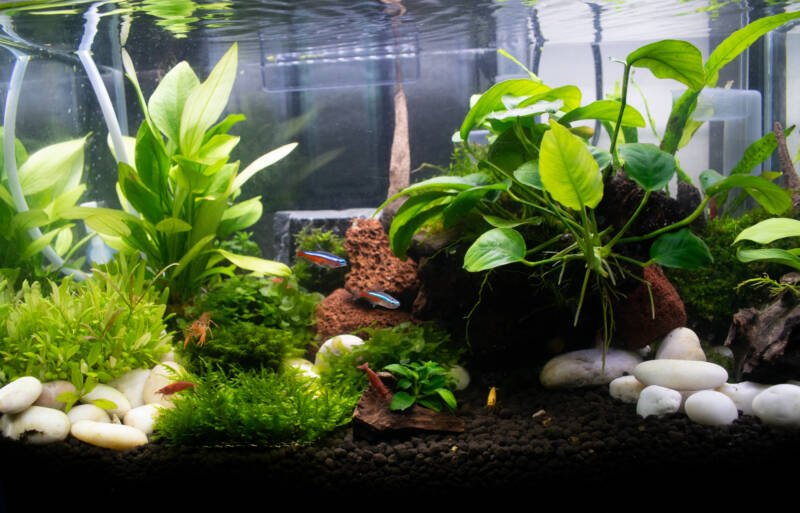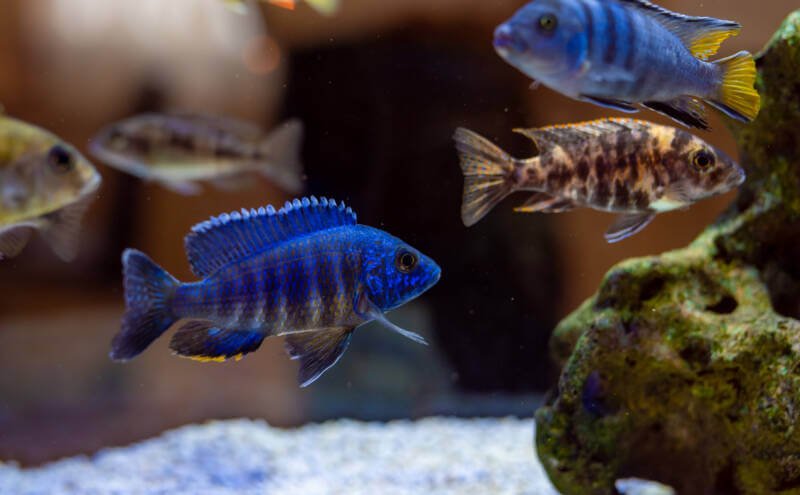Canister filters are one of the most advanced types of aquarium filtration. They hold a lot of filter media and pump a large volume of water.
They can be used on any freshwater or marine aquarium.
A canister filter can really improve water quality and make the tank crystal clear. But no matter how advanced your filter is, it won’t work properly if it isn’t properly maintained.

Here’s what you need to do to keep your canister filter working at peak efficiency.
In this article
How aquarium canister filters work
While canister filter designs vary, they all work on the same basic filtration principles.
The canister is loaded with one or more kinds of filter media. The media, like activated carbon, may be used in a mesh pouch or placed in one of several media trays that stack inside the canister.
Several types of media are often used inside the canister. The canister lid clamps onto the canister, making it air and water-tight.
The filter’s water pump circulates water from the aquarium through the filter media and back to the aquarium.
Filter media and canister filters
There is a variety of filter media suitable for canister filters.
Most filters come with foam pads designed to capture pieces of debris like solid fish waste, uneaten food, and other particles. Activated carbon removes substances that discolor the water and cause odors.
Biological filter media are designed to provide a surface area for beneficial bacteria to grow on.
These bacteria eliminate harmful ammonia and nitrite, which are produced when fish waste is broken down by biological processes.
You can also use specialty media like phosphate removers. Some reef aquarists use canister filters to hold nitrate removers, granular ferric oxide (GFO), and other specialty filter media.
Why do canister filters need to be cleaned often?

Aquarium water, even when it looks clear, contains a lot of tiny debris. Things like algae cells, bacteria, pieces of fish slime, and other natural materials are always in the water.
Solid fish waste also floats around as it disintegrates into smaller pieces. As fish nibble flakes and pellet food, the crumbs are released into the water.
All of these particles get captured inside the canister filter. As a result, sponge filters eventually become clogged.
The same thing happens with activated carbon and other adsorptive filter media. Debris gets caught between the media granules, slowing down the flow rate.
These organics also coat the adsorptive surface of the media, reducing their ability to remove colors, odors, phosphate, and other substances.
The high flow rates of canister filter cause a lot of solid debris to be removed by the filter. This will cause the filter to clog in a relatively short time.
What happens when a canister filter isn’t cleaned?
When you first set up your canister filter, it will pump a lot of water. The aquarium water will be crystal clear for several weeks.
But as time goes on, the filter will clog. You’ll notice a decline in its performance. Much less water will flow through the canister filter.
The aquarium water won’t look as clear, and you may even detect an odor. The filter may even stop pumping water.
All of these things happen when a canister filter is plugged up with dirt. The solution is a thorough cleaning.
How to clean a canister filter
Here are the basic steps to cleaning your canister filter.
It doesn’t matter what filter brand you have or if it is on a freshwater or saltwater aquarium. Adapt these steps to your own model of canister filter:
- Disconnect the power cord.
- Your filter probably has a quick-disconnect valve making it easy to remove the hoses from the canister. Separate the hoses from the canister.
- Carry the canister to the kitchen sink. It will be heavy because it is filled with water.
- Remove the lid and pour the dirty water down the drain.
- Discard old activated carbon and other granular filter media.
- If the sponges are old and brittle, replace them. You may be able to squeeze the dirt out under running water.
- Biological filter media can be rinsed in a container of aquarium water. Don’t use hot tap water because it can harm the bacteria living on the surface of the media.
- Wipe dirt from the media baskets. You can use an old toothbrush to scrub away dirt.
- Thoroughly clean the inside of the canister and rinse away slime and debris.
- Inspect the O-ring on the lid. It should be smooth and tightly held on the lid. If it is loose, replace it to prevent leaks.
- Cleaning the impeller.
The only moving part in the filter is the magnet and impeller. Over time it will become coated with slime, reducing its ability to pump water.
Sometimes a snail shell or piece of stringy saltwater algae will clog up the impeller. These steps will help you to solve the issue:
- Remove the impeller cover to access the impeller. The cover will be on the underside of the canister lid.
- Carefully pull the impeller out of its chamber. Notice that the impeller spins on a shaft. There are rubber bushings on each end of the shaft. Do not lose them!
- If your canister filter came with a tiny cleaning brush, use it to scrub the magnet, impeller, and impeller chamber.
- Flush away the debris and reassemble the impeller and cover.
Can soap be used to clean a canister filter?
Dish detergent is an ideal sop for cleaning your aquarium filter. It will loosen slime and debris and make cleaning the filter easier.
When you’re done scrubbing the filter, give it a thorough rinsing with tap water. The detergent will wash away, just like it does with dishes.
Adding fresh filter media
Replace the old filter media with new sponge pads, activated carbon, and other specialty media.
You can rinse dusty media by placing it inside a media basket and gently rinsing it in the sink.
Many aquarists wonder what the right order is when adding different filter media to a canister filter. Here’s how to do it:
- Place particulate filters, like sponges and filter pads, into the first basket or layer. The idea is to capture debris before it can clog the other filter media.
- Place adsorption media, like activated carbon and ammonia remover into the canister next. Your filter may have several baskets for granular media.
- The final stage is the biological filter media if you use it. Some aquarists use the space for more media like GFO for reef tanks.
Tips for a leak-free canister filter
While you’re cleaning and assembling your canister filter, be sure to check the hoses and fittings.
Flexible tubing can become brittle over time. Replace the hoses if they are too stiff.
Hand-tighten compression fittings are used to clamp the hoses to the quick-disconnect valve. Loose fittings can leak!
How often should I clean my canister filter?
In most cases, servicing your filter once a month will keep it working properly.
If you have big fish that produce a lot of solid waste, you’ll probably need to clean the filter every three weeks.
Final Thoughts
Every aquarist wants a clean, healthy aquarium. Canister filters are ideal for filtering freshwater tanks and reef aquariums containing corals and other invertebrates.
The best way to keep your canister filter working efficiently and purifying the aquarium water is through regular cleaning and maintenance.
Many aquarists have a monthly maintenance schedule for water changes, algae scraping, and filter cleaning.
Try it, and you’ll see what a difference it can make.